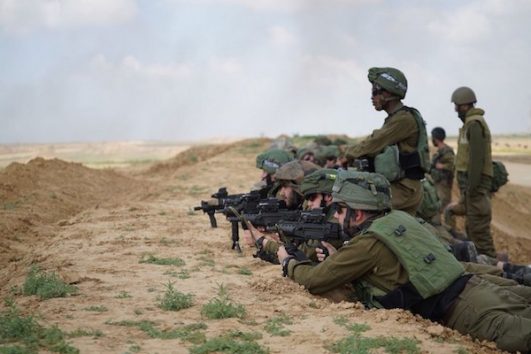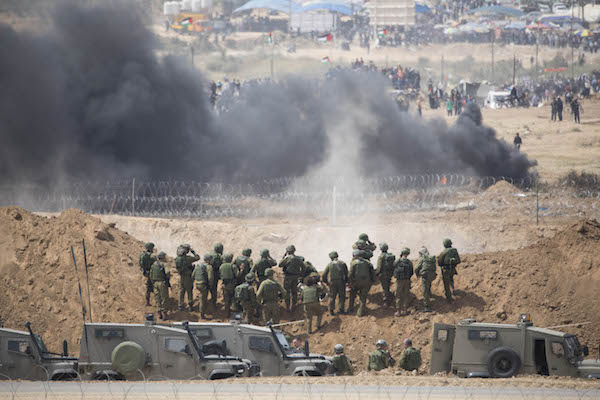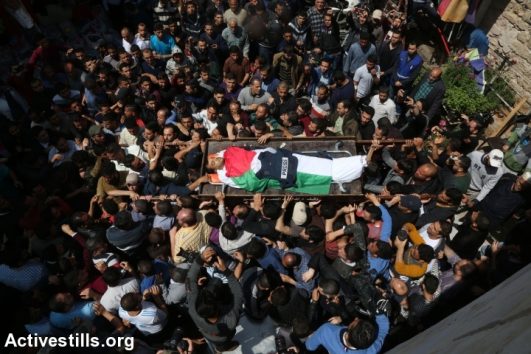Human rights groups argue the army’s open-fire regulations violate international law. The government claims the use of deadly force is justified — even against unarmed demonstrators.

Israel’s High Court of Justice heard on Monday a major challenge to the IDF’s rules of engagement, which permit the use of live fire against demonstrators who pose no danger to human life.
Monday’s session saw opening arguments in two petitions submitted by several prominent human rights organizations — one by the Association for Civil Rights in Israel (ACRI), Yesh Din, Gisha, and HaMoked: Center for the Defence of the Individual and one by Adalah and Al Mezan Center for Human Rights — in the wake of deadly violence against mostly unarmed Palestinian demonstrators in Gaza over the past month.
While the IDF’s open-fire regulations are not publicly available — the army refused to disclose the rules of engagement in response to the petition, claiming that they are classified — the army’s actions at the border and statements made by top commanded formed the legal basis for the petition.
The human rights organizations argue that there is no prohibition on holding demonstrations in Gaza, that violence or attempts to cross or damage the Gaza barrier fence should be seen as civil disturbances — not armed warfare — and, therefore, that the demonstrations are neither subject to the laws of war nor instances in which the use of live fire is justified.
“The state is referring to passages that turn international law on its head,” said attorney Michael Sfard, representing Israeli NGO Yesh Din, during Monday’s hearing. Sfard charged that the government had fabricated a new legal category to justify using deadly force against individuals who present no immediate danger to human life, but who are part of a mass or large group that could pose a danger in the future.

On the one hand, Sfard pointed out, the state has not defined the Gaza protsters as combatants. On the other, the state claims that it can use deadly force against protesters as instigators — even if they do not present an immediate threat.
“The use of deadly force against a civilian is only permitted if that civilian poses an immediate danger, these are the rules of international law,” Sfard stated. “We are dealing with the most dramatic power the state has — to injure, to wound, to kill. This isn’t the place for legal games.”
Attorney Avi Milikovsky, representing the state, argued that international legal rulings against the use of live fire against unarmed protesters do not apply to the protests in Gaza, which, he asserted, are part of Hamas’s armed struggle against Israel. Even if unarmed, Milikovsky continued, the protesters are being directed by Hamas and therefore the rules of war apply, rather than the rules of policing and international legal statutes regarding the use of deadly force against unarmed civilians.
“The state is claiming that the demonstrators, by the mere fact of their participation, might pose a threat in the future, which makes them a legitimate target,” said attoreny Suhad Bishara, of Adalah, after the hearing. “And we think this is a war crime.”
Since the Gaza Return March protests began on March 30, Israeli forces have shot and killed at least 40 unarmed Palestinians, including two journalists, Yaser Murtaja and Ahmed Abu Hussein — both of whom were wearing vests clearly marked “PRESS.” Israeli snipers have wounded at least 1,500 other protesters, according to UN data published last week.

Earlier in April, Fatou Bensouda, chief prosecutor of the International Criminal Court, warned that “violence against civilians – in a situation such as the one prevailing in Gaza” could constitute war crimes. Anyone who orders, encourages, or carries out that violence, she said, “is liable to prosecution before the Court.
In a newspaper ad campaign published earlier this month, human rights group B’Tselem urged Israeli soldiers to refuse orders to shoot unarmed protesters.
Despite the international criticism and calls for an independent investigation into the killing of unarmed demonstrators in Gaza – among them several children – Israeli authorities have doubled down on the decision to deploy snipers along the Gaza border with orders to open fire on unarmed protesters.
The High Court hearing adjourned without a verdict. Both sides have a week to present additional briefings to the Court.

